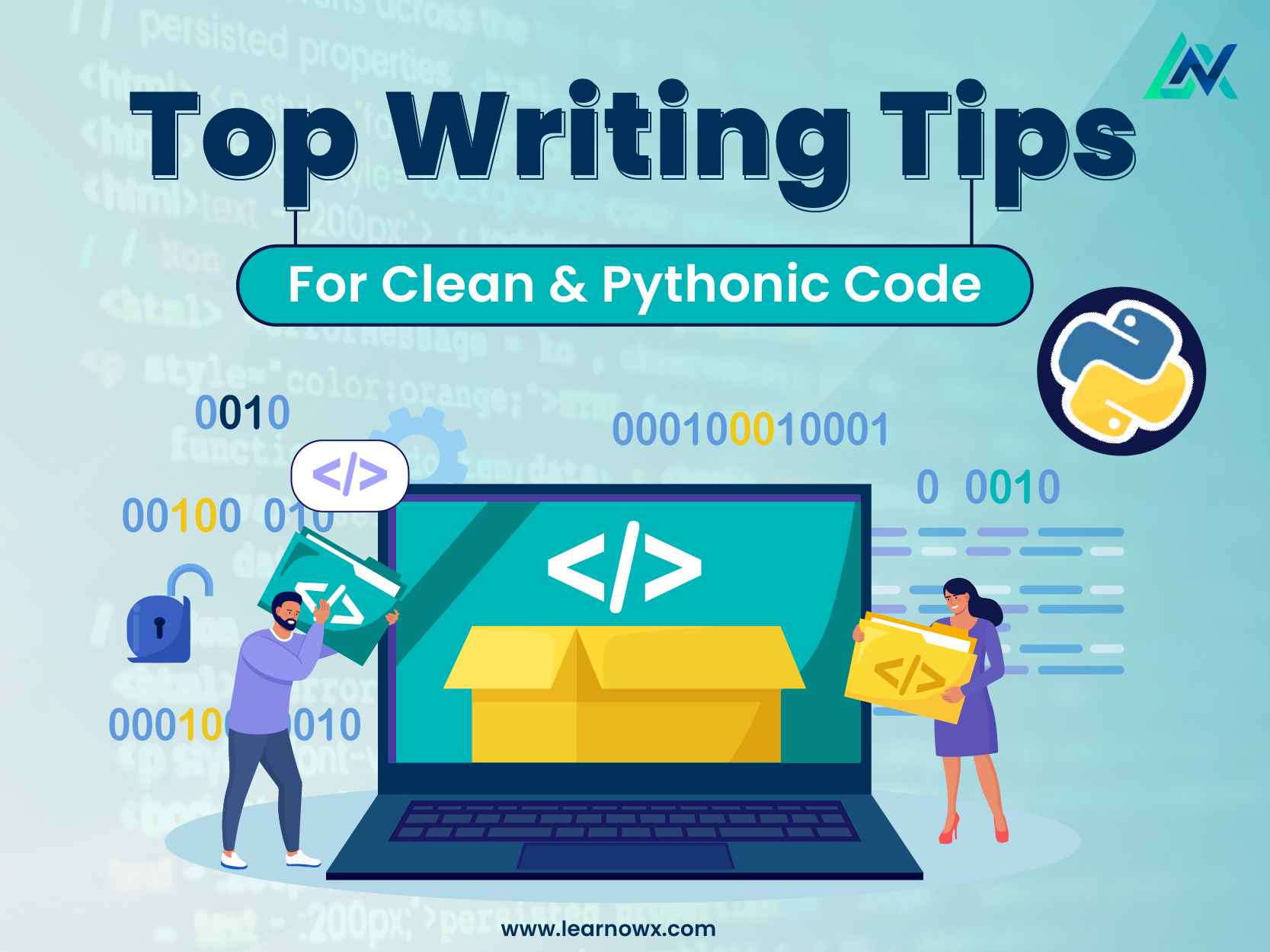Sharing is caring!
In today’s digital era, coding is a universal skill, and anyone with a computer and an internet connection can learn to write code. However, there is a notable difference between knowing how to code and being a proficient programmer. To become an adept programmer, you must understand not just the syntax, concepts, and semantics of a programming language but also the art of writing clean, elegant, and Pythonic code. But what exactly does it mean to write Pythonic code, & how can beginners embark on the Python programming for beginners’ journey?
In today’s blog, we help you understand what it takes to write clean and Pythonic code to stand out from the crowd and become a more proficient developer. And if you are looking for the ultimate Python Certification Course to kickstart your learning journey, the LearNowX Python course is what you need.
What is Pythonic Code?
Pythonic code refers to the philosophy and principles of writing efficient, elegant, and idiomatic code in the Python programming language. It encompasses more than just syntax and reflects the core principles of simplicity and readability that Python is renowned for.
Adhering to guidelines and best practices established by the Python community is crucial when writing Pythonic code. These guidelines are outlined in Python Enhancement Proposals (PEPs), with PEP 8 being one of the most vital. PEP 8 defines the coding style and conventions that Python programmers should follow. However, the Pythonic code is not limited to just PEP 8; it also embodies the Pythonic way of thinking and problem-solving.
Top Tips For Writing Clean & Pythonic Code
For beginners looking to become proficient Python coders, these seven essential tips will help guide you on the path to writing clean and Pythonic code.
1. Use Descriptive Variable Names: One of the most essential Python programming practices is to use descriptive variable names. It’s crucial to choose meaningful names for your variables and functions that explain what they do.
For instance, instead of using something unclear like x, use a more descriptive name such as total_price. Having well-named variables and functions boosts code readability and maintainability to make it easier for all to understand and modify your code.
2. Indentation and Consistency Matter: Another crucial Python programming practice is to follow a consistent style with 4 spaces for indentation. This makes your code look clean and organized. Consistency in indentation fosters collaboration and ensures your code is more readable and maintainable. When you use consistent indentation, it’s easier to notice bugs and issues in your code, and makes it easier for others to read and understand your code.
3. Keep Functions Small: When writing Python code, keep your functions small and focused on doing one specific thing. When a function has a single responsibility, it becomes easier to test, debug, and reuse in other parts of your codebase. This promotes a more modular and maintainable software design, where you can easily modify and extend the code without affecting other program parts.
4. Comments Wisely When Needed: A good practice in Python coding is to use comments to explain complex parts of your code, but only when needed. It’s better to write self-explanatory code with good names than to rely on comments to explain what your code does. If you do decide to use comments, make sure they provide additional context or clarify unusual logic, not just reiterate what the code is doing.
5. Follow PEP 8: Another tip for writing clean and Pythonic code is to follow PEP 8, Python’s style guide. PEP 8 suggests conventions for code formatting, such as using 4 spaces for indentation & clear and concise variable names. Following PEP 8 helps you keep your code consistent and readable, making it easier for you and others to understand, maintain, and collaborate on your code.
6. Use List Comprehensions: When working with lists, use list comprehensions to simplify loops, making your code shorter and more readable. List comprehensions offer a clear pathway to create new lists based on existing ones, resulting in shorter and more readable code. List comprehensions are also more efficient for simple data transformations in a list.
For example, [x**2 for x in numbers] instead of a long loop.
7. Document with Docstrings: Write clear explanations inside your code using docstrings to help others understand how your functions work. Well-documented code is not only beneficial for others but also for your future self when you revisit your code.
It’s essential to document your code using docstrings, known as the clear explanations written inside your code that help others understand how your functions work. Well-documented code is not just useful for others, but it also helps you when you revisit your code in the future.
8. Use Built-in Functions: To simplify your code in Python, it’s an ideal choice to use many built-in functions and libraries available. This will help you avoid writing complex custom code and often result in more efficient and optimized solutions. So, make sure to leverage the power of built-in functions and libraries in Python whenever you can.
9. Write Tests: Creating tests for your code is a crucial step to ensure its correctness and robustness. This helps catch and prevent bugs early on in the development process. Test-driven development (TDD) is a valuable approach where you write tests before implementing code. This approach helps you clarify requirements & design to make your code more reliable and easier to maintain in the long run.
10. Use Pythonic Constructs: When writing code in Python, it’s important to take advantage of its unique features like iterators, generators, and context managers when appropriate. These Pythonic constructs can significantly improve code readability, enhance performance, and manage resources more efficiently.
11. Use a Linter and Formatter: Using a linter and code formatter in your coding process can save you time and help ensure your code is well-structured and adheres to Python’s style guidelines. A linter like Pylint checks your code for errors and provides suggestions for improvement, while a code formatter like Black automatically formats your code according to PEP 8 guidelines.
12. Don’t Repeat Yourself (DRY): The DRY (Don’t Repeat Yourself) principle is crucial for writing efficient and maintainable code. Reusing code and creating functions can help you avoid writing the same logic multiple times in different parts of your codebase. By following the DRY principle, you reduce redundancy and simplify maintenance, as you only need to update a single piece of code when changes are required.
13. Optimize Loops: Choosing the right data structures and techniques for loops can significantly improve your code’s performance. For example, using sets or dictionaries for faster data retrieval instead of lists, where appropriate. By optimizing loops, you can make your code more efficient and reduce the execution time, resulting in better performance.
Final Words
Writing clean and Pythonic code is an art and a craft that every aspiring Python programmer should strive to master. It’s more than just adhering to coding conventions; it’s about creating code that is easy to read, understand, and maintain. These seven tips provide a strong foundation for beginners to start their journey towards Pythonic excellence. Remember, becoming a proficient Python coder is a continuous process, and as you gain experience, you will develop your coding style and practices.
Are you interested in learning how to write clean, readable, and maintainable Python code? The Python Certification Course by LearNowX is the perfect choice for you! Through this course, you can gain a comprehensive understanding of Python programming best practices and learn how to apply these principles in your code. Don’t wait any longer; apply now and take the first step into the amazing and powerful world of Python Programming!








